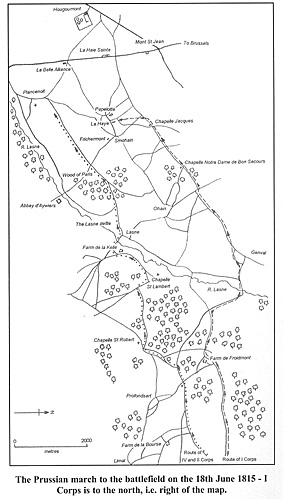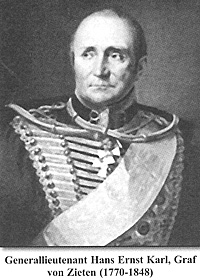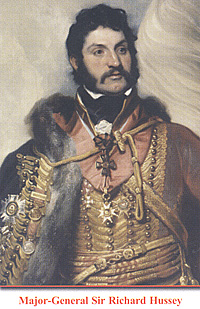Left Wing History (2):
Waterloo 1815
Prussian I Corps
by Gary Cousins, Germany
| |
“…no consequent misunderstanding…” The first units of the advance guard of Zieten’s Prussian I Corps began to arrive
north of Ohain, about 3km from the edge of the battlefield, at around 6 p.m.
on the 18th June. [1]
This article will examine its march and some implications for the left wing and Vivian’s 6th Cavalry Brigade.
The Prussian march to the battlefield on the 18th June 1815 - I Corps is to the north, i.e. right of the map.
According to its Tagebuch, it was peaceful overnight on the 17th / 18th June at Bierges near Wavre, where I Corps was in bivouac, but at 2 a.m. on the 18th June, Zieten received a message from headquarters, written at midnight, telling him of the Prussian plans for the 18th June, and that he was to have his troops cook as early as possible, in order to be ready to march at short notice.
[2]
The Tagebuch says that on the morning of the 18th June,
Blücher issued an order to I Corps, which arrived at around 12
midday, to march towards Mont St. Jean. [3]
Blücher left Wavre at around 11 a.m. to join his advancing troops: the order was apparently verbal.
[4]
The Tagebuch says that it was prompted by the sound of fighting from the west at Mont St. Jean,
which was heard “very early”, which, however, only began at
around 11.30 a.m.; French inactivity against the Prussians around
Wavre may also have been a factor.
[5]
According to Zieten’s own report of the campaign, and a letter written not long afterwards by
his chief of staff Oberstleutnant Ludwig von Reiche, the order
arrived at 1 p.m., [6] although Reiche’s later memoirs give the time of
arrival as 12 p.m. [7]
The Tagebuch says that Zieten now issued a Disposition, which began:
“The 4th, 2nd and 1st Army Corps are to march in two columns,
such that they can support the Duke of Wellington, who stands with
his right flank by Brain-la-Leud and his left by Mont-St.-Jean, and
create a diversion for Bonaparte in his right flank. The 4th and 2nd
Corps will form the left wing: they will march through Neuf
Cabaret to St. Lambert. The 1st Army Corps will form the right-wing
column. It will march through Fro[id]mont towards Ohain.”
The Disposition went on to specify that the advance guard
would be 1st Brigade plus one horse battery and one foot battery,
supported by the Reserve Cavalry, (which would also maintain
the link with the II and IV Corps); followed by 2nd, 3rd and 4th
Brigades, and the Reserve Artillery. [8]
Generallieutenant Hans Ernst Karl, Graf von Zieten (1770-1848)
(A more eccentric account, supposedly by Zieten, says:
“...I had received no Disposition by 10 a.m. on the 18th
June, but I had learned from Generallieutenant von Bülow his
march direction. I knew the position of the English, and I
inferred that the I Army Corps had to take up
the vacant position between the right wing of
Generallieutenant von Bülow and the left of
the Scottish [sic!]. At around 11 a.m. I gave
the Disposition on my own initiative, took the
march direction, and was richly rewarded,
because I arrived at the right time to save the
Scottish…” [9] )
Yet the Tagebuch (and Reiche) record
that I Corps only began to move at around 2
p.m., [10] and the rearmost 4th Brigade was seen
still around Bierges towards 4 p.m. [11] It is not
easy to account for the delay. The Tagebuch
claims that for the retreat of the 16th and 17th
June, I Corps was in battle-ready condition, [12]
which, after the Battle of Ligny on the 16th
June, must be some exaggeration. But when
the Prussian ammunition columns arrived at
Wavre in the late afternoon on the 17th June,
supplies were apparently immediately
replenished, [13] and having been most heavily
engaged at Ligny, this might have been a
priority for I Corps – either when its troops,
initially allowed to forage in the villages
around Bierges, were pulled together into one
bivouac that evening, [14] or at latest the following
morning, given Blücher’s overnight order
to be in readiness first thing. However, what
baggage had not been lost during the retreat
after Ligny had been directed to Louvain by
Blücher’s overnight order of 17th / 18th June,
and nourishment had been difficult to come by
around Bierges. [15]
The troops were tired, hungry and wet
through after the overnight rain, and the march
went along poor and muddy country roads
intersected with significant defiles; but the
order had been well-received, and the troops
were apparently in good spirits and marched
eagerly to revenge the defeat at Ligny, especially
as they approached their objective [16] .
However, the route to be used by I Corps
crossed that of the left wing column, and while
Zieten’s advance troops may have slipped
through a gap in the march columns of II
Corps (the departure of which was also delayed,
and which still occupied the route), the rest were held up. [17]
The Tagebuch also points out:
“Because the fire grew ever stronger
upon one and the same point, and even the
arrival of the 4th and 2nd Army Corps on the
battlefield had changed nothing there, so it
was necessary…not to let the troops become
separated from each other. However, it was
also just as necessary to appear on the battle-field
as soon as possible.” [18]
During his march, Zieten had to look to his front, to his left flank to maintain communication
with the II and IV Corps, and all around in case of a French attack; his orders,
dispositions and actions throughout the day
suggest how, after the experiences of the last
few days, and under the current threat, the
need for security competed with the need to
get to the battlefield as soon as possible. [19]
At some point along the route there may
have been a “misunderstanding”, leading I
Corps to take the wrong road: it marched
further to the north than intended, towards
Genval, along a more difficult route which
went directly to Wellington’s front, instead of
along a relatively good road which would
have led it into the Ohain valley. It has been
suggested that this cost valuable time, and
meant that I Corps did not enter the battle at
the intended place, between Wellington’s position
and the Prussian army on the main battlefield. [20]
Zieten’s “Disposition” charged
Major Dendenroth, assistant chief of staff to I
Corps, to direct the head of the column; [21] and
Reiche, chief of staff to I Corps, seems to
have been sensitive to the “misunderstanding”
being mentioned in a later campaign history,
and told its author Hofmann that “...Ohain was
not indicated in the order at all, therefore there
was no consequent misunderstanding…” -
which Hofmann rejected; [22] in Reiche’s memoirs,
which were published later, Zieten’s Disposition
was reproduced, with Ohain clearly
indicated as the march direction. [23]
However, the verbal order which Zieten received around
midday was presumably no more specific than
the order he gave in his Disposition (see
above) to I Corps: to march “through
Fro[id]mont towards Ohain”, and to “support
the Duke of Wellington” by creating “create a
diversion for Bonaparte in his right flank.”
Otherwise, it is unclear what was intended for
I Corps to do on the 18th June.
There was an exchange of messages
around midday and early afternoon, wherein
Müffling (with Wellington’s agreement) proposed
to the Prussian command three possible
options for the Prussian intervention on the
main battlefield: in case 1, if the French attacked
Wellington’s right, the Prussians
should reinforce Wellington from Ohain; in
case 2, if the French attack was upon
Wellington’s left or centre, the Prussians
should intervene “from the line of heights”,
thus “leaving the difficult valley at La Haye to
the right” (case 3 need not concern us here).
When the battle began, Bülow at Chapelle St.
Lambert was told that case 2 had occurred,
and in his acknowledgement he said that his
IV Corps would therefore attack the French
right flank, and he added: “My advice is that
another corps then goes through Ohain, in
order, according to the circumstances, to be
able to support the most threatened point of
the English position.” It seems that Wellington
agreed to this, although there is some
evidence that initially he wanted IV Corps to
enter the battlefield closer to Wellington’s
position. [24]
How the development of these plans impacted
upon I Corps is unclear: although, according
to Zieten’s Disposition, I Corps was
to maintain contact (via its Reserve Cavalry)
with the other corps (and presumably Prussian
headquarters), it seems no specific record survives
of any messages concerning its cooperation
with Wellington and Bülow which may
have passed while it was in mid-march.
As will be seen later, when I Corps eventually
appeared on the Ohain road, it seems to have
been expected, and Wellington will not have
been displeased; and the accounts left by the
staff of I Corps do not suggest that they felt
they were doing anything wrong in going
directly towards Wellington’s position and to
his support - although Blücher might not have
felt the same way at this point. There are some
echoes here of the situation which prevailed
when Wellington and the Prussians discussed
how best they could cooperate on the 16th June.
The most potential for danger and delay
was at the Lasne defile, which could easily
have been occupied by the French, and where
there was probably only one bridge across the
stream. [25]
According to the Tagebuch, the infantry of the advance guard occupied the
defile, and from there Zieten had the Reserve
Cavalry and the two batteries of the advance
guard sent forwards as quickly as possible: in
the meantime, the 1st Brigade formed up, and
resumed its march as soon as the head of the
main body of I Corps arrived, to which was
given the order, that each brigade, as it crossed
the defile, was to assemble and follow the advance guard without
delay. [26]
According to Zieten’s own report of the campaign, the
advance troops, comprising the 1st Brigade and the Reserve Cavalry
together with four batteries, advanced rapidly, without waiting for the
other brigades, “…which could not come up yet because of the very
difficult defiles which were to be passed on this road.” [27]
As a result of this and other features of its march, I Corps, which
began the day the closest to Wellington’s position, by the day’s end
was stretched out between there and the action in which a detachment
from its rearguard became engaged near Wavre / Limale, [28] and it has
been estimated that only around 6,600 of its troops arrived in time to
help defeat Napoleon. [29]
By around 6 p.m. the advance units of I Corps were only north
of Ohain, [30] about 3 km from Wellington’s extreme left. According
to unit reports, I Corps was now being led by the 4th (1st Silesian)
Hussar Regiment and the 5th (Brandenburg) Dragoon Regiment, with
horse battery no. 7 and foot battery no. 7: the hussars reached the
heights near Ohain first, and established the connection with
Wellington’s army, apparently by sending forward detachments. [31]
The Prussians now had every reason to hurry, and Wellington had
every reason to expect their swift arrival. [32] But they were then further
delayed on the Ohain road, [33] and only really entered the action on the
battlefield from around 7 p.m. onwards. [34]
Key roles were now played by Reiche and Generalmajor von
Müffling, Prussian liaison officer at Wellington’s headquarters. [35]
Left Wing History (2) Prussian I Corps
Left Wing History (1) Waterloo 1815: Vivian's 6th Cavalry Brigade
|

 The Arrival of Zieten and the Prussian I Corps at Waterloo on the 18th June 1815
The Arrival of Zieten and the Prussian I Corps at Waterloo on the 18th June 1815

 Major-General Sir Richard Hussey
Major-General Sir Richard Hussey